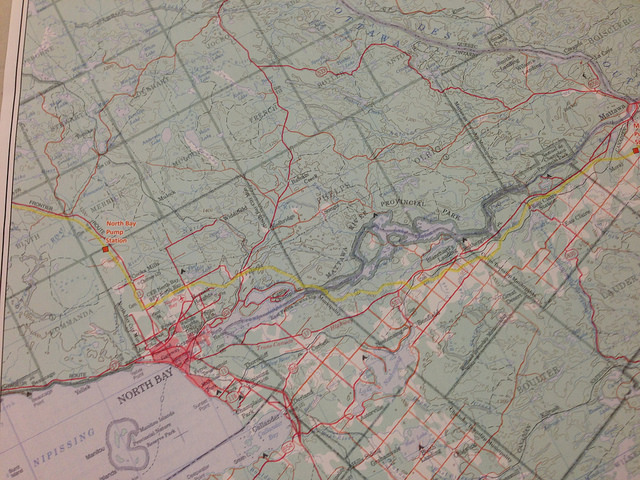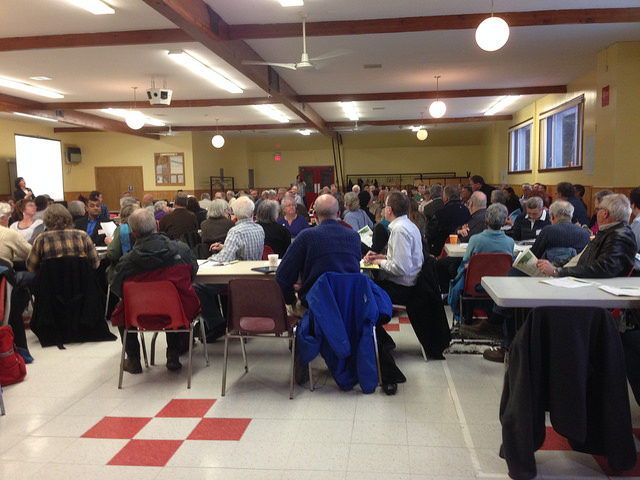Drawing well over 150 people, the Energy East consultation in Stittsville this week was a boisterous event with a clear majority questioning the project. There were outbursts of applause, communal guffawing and a clear sense that people had a lot to say about this undeniably controversial pipeline.
The overarching theme that emerged was the need for the Ontario Energy Board process to consider the significant climate pollution associated with the pipeline project. Many voices expressed that we are at a critical juncture on climate change, that we need to start reducing climate pollution. A project that could unleash the CO2 equivalent of all of the cars in Ontario for a year (Energy East would unleash 30 to 32 million tonnes of climate pollution every year) is simply not the right choice.
This is an important message for the OEB consultation which provides space to discuss climate implications, but does not have it listed as one of the consultation’s four areas of potential impact. It is also a key message the Ontario Minister of Energy could bring forward to the National Energy Board whose scope in previous pipeline reviews has not included upstream (production of the oil) impacts.
Others raised concerns about the potential for a tar sands diluted bitumen spill in the Rideau River, Ottawa’s water supply that connects to the Rideau Canal, a UNESCO World Heritage Site. The highly vulnerable aquifers of the Ottawa region were also of great concern. A number of interventions also raised the question of compensation from TransCanada in the event of a spill.
I certainly enjoyed the opportunity to hear people clearly express their questions and concerns, from students to business owners to farmers, land owners and retirees.
Another highlight of the event was the opportunity to capture in photographs two maps of the pipeline route in Ontario. These maps are far more detailed then what TransCanada has supplied to date and help connect the dots between some more detailed local maps that local residents have supplied (from their city or TransCanada).
Please circulate broadly:

Below are the speaking notes from my presentation last night. I’m off now to Cornwall tonight for the final stop on the OEB’s 7 community tour.
Good evening,
I want to start by thanking the Minister of Energy for providing this opportunity to collect Ontarians’ views on the Energy East pipeline, what would be the largest oil pipeline in North America.
I am the Energy and Climate Justice Campaigner with the Council of Canadians. We are a national organization that works in the areas of democracy, water, trade, health care and energy. We are sustained by over 75,000 supporters, we work with close to 70 volunteer chapters across the country, including six directly impacted by the Energy East route.
We firmly believe there are many risks and few benefits for Ontarians from this pipeline. We believe these risks are sufficient for the province to take a strong position against the project.
Export
The Council of Canadians alongside 3 environmental organizations recently released a report questioning proposed benefits of a stronger oil refining industry and greater energy independence.
The report looked at available capacity of the 3 refineries along the route and compared it to the sources available and soon to be available to these refineries which you can see here [power point slide featuring graphs in this report].
The conclusion is that the vast majority of the oil transport, between an estimated 750,000 to 1 million barrels per day would likely be exported, unrefined.
This conclusion is supported by recent comments made in the media by Enbridge and the spokesperson of the Valero refinery regarding Quebec refineries capacity.
Meanwhile provinces and communities along the route bear the impacts.
Climate risks:
At a time when we are warned that two-thirds of all fossil fuels need to stay in the ground to avoid the worst of climate change, infrastructure contributing as much climate pollution as this pipeline would, is a concern to us all. For our generation, for my son’s generation and all future generations.
According to a report by the Pembina Institute, filling Energy East would produce 30 to 32 million tonnes of climate pollution every year.
This would literally undo the good done by Ontario’s phase-out of coal and by our electricity policy.
Upstream impacts should be a priority in examining the implications of this pipeline, both with the OEB, and as a message the Ontario government brings to the NEB.
Diluted bitumen:
Energy East would carry diluted bitumen or “dilbit,” created by diluting thick, bitumen from the tar sands with various chemicals to make it thin enough to transport by pipeline.
Massive pipeline ruptures in Mayflower Arkansas in 2012 and Kalamazoo Michigan in 2010 show how difficult it is to clean up dilbit because it sinks in water and is very sticky.
Ottawa region:
A diluted bitumen spill poses heightened risks in this area. Not only could a spill enter the Rideau River, an important drinking water source, it enters a region with highly vulnerable aquifers.
The more easily water or other fluids can flow through the ground to the aquifer, the more vulnerable the aquifer is to contamination. The red regions on this map are highly vulnerable [referring to this startling map].
This includes the Oxford aquifer which more than 70 per cent of homes in North Grenville draw their drinking water from. The pipeline crosses this aquifer
Aquifers are also more vulnerable in recharge areas. The pipeline crosses such a recharge area in North Grenville (see the maps here).
We are concerned about increased reliance on imported fracked gas from the U.S.
We are also concerned about how the conversion of this pipeline will impact the supply of natural gas in Ontario. In particular, we are concerned about growing dependence on fracked gas imports from the U.S. Marcellus shale.
We have brought evidence before to the Ontario Energy Board previously regarding how environmentally and socially damaging this gas is, and the likelihood it will be subject to increasingly punitive regulations, making this gas less available and more expensive. It also means the gas used in Ontario has a much higher carbon footprint.
We don’t believe the report commissioned by the OEB effectively evaluates this risk.
Finally we are concerned about the federal regulation of this pipeline.
The Harper government has gutted environmental regulations in this country. It has left resource project decisions to the National Energy Board and has simultaneously made participating in this process incredibly difficult for people.
It is up to people like us to be informed and active, to participate in spaces like this, and raise our concerns. Doing so, we firmly believe the right choice is to stop the Energy East pipeline.
Thank you for the opportunity to share, I look forward to our discussion.




